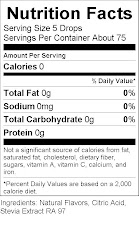A beverages flavor descriptor for flavored water and other beverages is a signal to what’s in the drink. Not all descriptions are approved by the FDA, so now you have to deal with fantasy descriptions such as “pure flavoring” and “all natural flavors” along with descriptions that are on point but still just as confusing: “natural”, “artificial”, “natural and artificial”…phew! More on flavoring descriptions later.
1. The Nutritional Facts Panel- Here are the nutrients you want to drink or eat less of (saturated fat, cholesterol, sodium and sugar) as well as those you want to get enough of (vitamins, minerals and fiber). A flavored bottled water, beverage or food that provides 5 percent or less of daily value is considered to be low in that nutrient, while a food is considered a good source of a nutrient if one serving provides 20 percent DV.
 2. The Serving Size: This is the first nutrient line on the label and the basis for all the numbers and percentages that follow. If you don't check serving size, you could be drinking more calories than you realize, even in something as simple as flavored water. For example, a single serving of your favorite fruit juice is typically one cup, not two, so you’re normal drinking glass could be doubling your actual calorie intake, doubling the calories, fat, carbohydrates, etc. without you even realizing it.
2. The Serving Size: This is the first nutrient line on the label and the basis for all the numbers and percentages that follow. If you don't check serving size, you could be drinking more calories than you realize, even in something as simple as flavored water. For example, a single serving of your favorite fruit juice is typically one cup, not two, so you’re normal drinking glass could be doubling your actual calorie intake, doubling the calories, fat, carbohydrates, etc. without you even realizing it.4. The Nutrients: This box lists what's in the beverage, including any added nutrients, fats or sugars. Ingredients are listed in order by weight, from the largest to the smallest. So if you want to cut back on sodium or sugar, don't choose a beverage, flavored water or food product with sugar as the first ingredient. And don't be tricked by different forms of fat and sugar listed with unfamiliar names. If you want to know how much sugar is really in a product, look for what we call the “osis” words that end in "ose" -sucrose, dextrose, fructose - as well as more common synonyms: corn syrup, molasses and honey.
5. Descriptors: What does “pure flavoring” or “all natural” really mean? What does "light", "fat-free" and "low-sodium" really mean? Here's how the FDA defines these words: low-saturated fat (one gram or less per serving); low-sodium (140 milligrams or less); low-cholesterol (20 milligrams or less and 2 grams or less of saturated fat); low-calorie (40 calories or less). Light beverages and foods have two-thirds the calories of the regular variety. Note: It’s important to understand that just because a product is low-fat or low-sugar that does not necessarily me low calories. Here' an example of our flavor concentrate nutrient label.

6. According to the FDA, there are really only three approved flavor descriptors, well 4 if you include spices. Here’s a brief summary and some of the more common language used:
C. Natural & Artificial- A combination of natural and artificial flavorings.
So, when it comes to flavoring descriptors for the flavored water or beverage you drink, you need to look further when a beverage touts, “pure flavoring”. Look deeper at fruit juices, they taste great but are loaded with high fructose corn syrups, even though they are natural flavorings. Look for alternative beverages that allow you to get all the flavoring with none of the calories, carbs and fats.
____________________________________________________
Sources: FDA/Govt. food, fourelders.org/tips
Online Resources: FDA/Govt. food, fourelders.org/tips







%2520(3-26-09).jpg)




